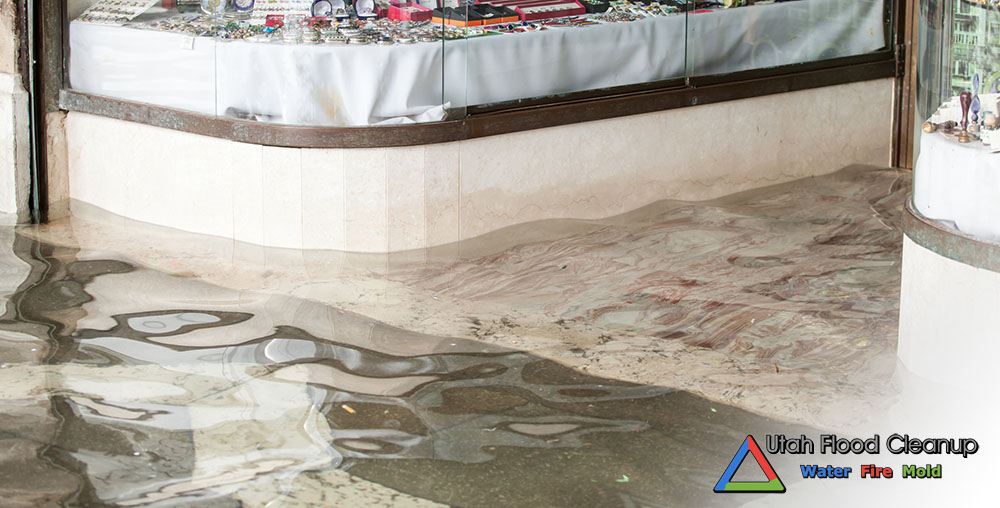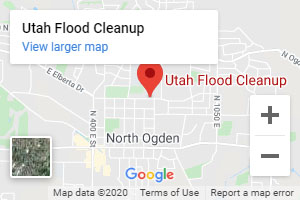Utah Commercial Flood Damage Repair and Commercial Water Damage Restoration Services in Ogden Utah
Water damage can be a major source of stress for any business owner, but there are some steps you can take to get your business back in working order as soon as possible. Utah Flood Cleanup provides commercial water damage restoration services throughout Ogden, Utah, and the surrounding areas.What is Commercial Water Damage?
Commercial flood damage is any damage that occurs to any type of business after a flood. From mold to electrical damage, there are a variety of potential issues that can arise after a flood. Often, the water damage itself is only the beginning.Water and Flood damage can happen without warning, making it difficult to protect your business. Broken water lines are one of the common causes of commercial water damage, as are storms that result in local flooding. Other commercial water damage can be caused by clogged toilets, aged plumbing systems, structural failure and cracks in the building foundation. The longer it takes to begin the cleanup process after a flood, the more damage will be done and the more revenue your business could lose.
Commercial Water Restoration and Flood Damage Restoration Near Ogden, Utah
Once water damage has occurred in a commercial setting, there are some basic steps that need to be taken in order to minimize the damage and begin the cleanup process.- Inspection: The first step in addressing water damage to your business is to complete a thorough inspection of the property. This not only makes it easier to assess the damage that has been done but also ensures that there are no immediate safety hazards present on the property as well.
- Water Removal: Removing excess water in a timely manner is the key to minimizing property damage after a flood. Most water damage occurs within 48 hours, so calling for assistance as soon as possible will help minimize your restoration costs. The longer the water sits, the more likely it is to cause mold and structural damage.
- Mold Cleanup: Removing any mold that has grown in or around your commercial property is the next important step in the cleanup process. Mold can pose a serious health hazard to you, your employees, and your patrons, and any flooring or materials that have been saturated with water pose the risk of developing mold and mildew. The best way to treat a mold problem is to act preventatively.
- Electrical Wiring: If the electrical wiring on your property has been affected by water damage, it may need to be replaced. It is important to work with an inspector who understands the dangers inherent in wiring that has been exposed to water and can prioritize safety throughout the cleanup process.
- Material Replacement: From office furniture and equipment to carpeting, drywall and flooring, a variety of materials around your business may need to be replaced after a flood. In many cases, restoration services can salvage your water-damaged property, saving you the cost of replacing valuable equipment and materials. Before you throw away important items after a flood, schedule an inspection to find out if they can be restored instead.
Frequently Asked Questions About Commercial Water Damage Restoration and Commercial Flood Damage Repair
It depends on the specific type of insurance policy, but oftentimes the answer is “no.” Usually, you’ll need a separate policy aside from your commercial property insurance if you want to safeguard your business from floods or water damage. While many people associate water damage with natural disasters, you may be surprised to learn that the two most common causes of commercial property damage are leaks and busted pipes, so you may want to double-check your policy to make sure you’re covered accordingly. However, keep in mind that leaks aren’t usually covered by insurance policies, as they’re often classified as something that should have been detected and repaired before the problem became too great.While contents that come into contact with the water may need to be removed and restored off-site, most contents can generally remain on-site and worked around by restoration professionals.It all starts with a quick response, then containing water and preventing it from spreading further throughout the property. After containment, any remaining water can be removed and drying practices can commence. In addition to performing water damage restoration, we’ll replace damaged porous building materials and remediate any mold that may have subsequently grown to return the property to a pre-loss condition.It all starts with a quick response, then containing water and preventing it from spreading further throughout the property. After containment, any remaining water can be removed and drying practices can commence. In addition to performing water damage restoration, we’ll replace damaged porous building materials and remediate any mold that may have subsequently grown to return the property to a pre-loss condition.Yes, and for two reasons. One, the quality of water may be hazardous to your health if it has mixed with sewage or other contaminants. And two, any subsequent mold growth may also be hazardous to your health. Our professionals wear the proper personal protective equipment (PPE) to stay safe from such hazards while we’re restoring your property. But staying and operating your business while work is being performed could leave you vulnerable to health risks.Like we noted above, the most common causes are leaks and busted pipes, but these are hardly the only two causes. Inclement weather can lead to flash flooding or roof damage, which can cause water intrusion. Other appliances that use water can also malfunction or overflow, such as sinks, toilets, HVAC units, hot water heaters, ice makers, etc.The answer is both “yes” and “no.” Busted pipes occur in cold weather after a pipe has frozen and expanded, so taking preventative measures during cold snaps can prevent this. And routine maintenance can also help prevent hose, plumbing and structural leaks. However, inclement weather is largely unpredictable and even with the right preventative maintenance, issues can still persist.
It depends on the specific type of insurance policy, but oftentimes the answer is “no.” Usually, you’ll need a separate policy aside from your commercial property insurance if you want to safeguard your business from floods or water damage. While many people associate water damage with natural disasters, you may be surprised to learn that the two most common causes of commercial property damage are leaks and busted pipes, so you may want to double-check your policy to make sure you’re covered accordingly. However, keep in mind that leaks aren’t usually covered by insurance policies, as they’re often classified as something that should have been detected and repaired before the problem became too great.
While contents that come into contact with the water may need to be removed and restored off-site, most contents can generally remain on-site and worked around by restoration professionals.
It all starts with a quick response, then containing water and preventing it from spreading further throughout the property. After containment, any remaining water can be removed and drying practices can commence. In addition to performing water damage restoration, we’ll replace damaged porous building materials and remediate any mold that may have subsequently grown to return the property to a pre-loss condition.
It all starts with a quick response, then containing water and preventing it from spreading further throughout the property. After containment, any remaining water can be removed and drying practices can commence. In addition to performing water damage restoration, we’ll replace damaged porous building materials and remediate any mold that may have subsequently grown to return the property to a pre-loss condition.
Yes, and for two reasons. One, the quality of water may be hazardous to your health if it has mixed with sewage or other contaminants. And two, any subsequent mold growth may also be hazardous to your health. Our professionals wear the proper personal protective equipment (PPE) to stay safe from such hazards while we’re restoring your property. But staying and operating your business while work is being performed could leave you vulnerable to health risks.
Like we noted above, the most common causes are leaks and busted pipes, but these are hardly the only two causes. Inclement weather can lead to flash flooding or roof damage, which can cause water intrusion. Other appliances that use water can also malfunction or overflow, such as sinks, toilets, HVAC units, hot water heaters, ice makers, etc.
The answer is both “yes” and “no.” Busted pipes occur in cold weather after a pipe has frozen and expanded, so taking preventative measures during cold snaps can prevent this. And routine maintenance can also help prevent hose, plumbing and structural leaks. However, inclement weather is largely unpredictable and even with the right preventative maintenance, issues can still persist.








